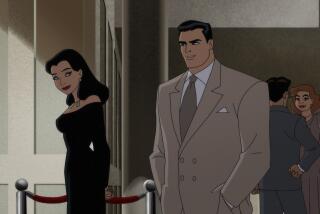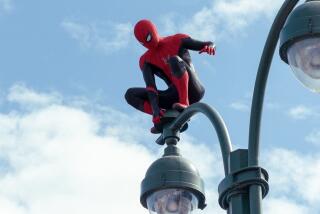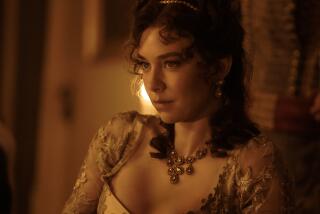Trailblazer of Comic Strips Still Drawing on His Talents
- Share via
Jack Kirby remembers quitting his job drawing Betty Boop animated cartoons while he was a teen-ager living in New York’s Lower East Side because the work was too much like the garment district piecework that was commonplace in the neighborhood he was trying to escape.
“We sat at rows of tables and got paid very little,” said Kirby.
His ambition “to create rather than duplicate” led him to begin work as a free-lance comic strip writer and eventually to create what comic book fans say is arguably the most impressive lineup of super-hero characters ever to battle for life, liberty and goodness.
During his 50-year career, Kirby created and illustrated such comic book heroes as Captain America, Spiderman, the Fantastic Four and the Incredible Hulk.
Although Kirby, 69, is now retired and lives comfortably in a hilltop Thousand Oaks home, he is still busy, creating new characters for his first motion picture. He said he will begin work with Empire Productions next year on a live action movie that will feature a new creation, Dr. Mortalis.
Adopts Comic Strip Name
Kirby, who changed his last name from Kurtzman to that of a comic strip adventure character named Rip Kirby, is regarded as one of the comic book industry’s major creative forces.
“If it weren’t for Jack Kirby, comics wouldn’t be the way they are today,” said Ralph Holt, owner of Ralph’s Comics in Ventura and one of many fans who grew up with Kirby’s creations.
Kirby is known for drawing the square jaw and rippling muscle physique that has become the standard for the comic book super-hero, said Bruce Goldstein, manager of Hi De Ho Comics in Santa Monica and another lifelong fan.
Kirby became known by comic book fans for the perspective that makes fists seem to fly off the page in the dramatic battles between forces of good and evil, Goldstein said.
“I never signed the magazine covers because my style was my signature,” Kirby said. “It was an action style of drawing that people could recognize on the newsstands.”
He said he found both escape and inspiration from watching his matinee idols, Edward G. Robinson and James Cagney. Kirby said he could identify with the two short but scrappy tough-guy actors “because, being a little guy all my life, I’ve always been in fights.”
Kirby said the inspiration for Captain America, created in 1940, was in part the fact he was a small but wiry New York kid, barely out of his teens, who still got picked on by the bigger guys in the neighborhood.
The comic book saga tells the tale of Steve Rogers, who is rejected from the Army because he is underweight. Rogers then volunteers for a top-secret government experiment wherein he takes a serum that magnifies his strength and agility, turning him into Captain America.
As he created villains for Captain America, Kirby said, he envisioned himself as the comic book hero. “It was me fighting 10 men. It was me fighting 25 men.”
The $82-a-week salary that Kirby received from Atlas Comics, the forerunner of Marvel Comics and the publisher of Captain America, was enough for Kirby and his partner Joe Simon to afford a studio in mid-town Manhattan and dinners out on the town.
“Captain America hit really big,” Kirby said. “It was then that my publisher knew that super-heroes were going to be a big commodity. . . . It was also when I really started to enjoy life.”
Short, Humorous Features
Before that, during the 1920s and 1930s, comics were exclusively short, humorous newspaper features, Kirby said. But, after publishers began to compile strips in comic books, the door opened for story-tellers such as Kirby to create longer, more serious tales.
“Like everybody else, I saw a chance to write dramatic stories,” Kirby said. He wrote and illustrated comic book Westerns, adventure stories and, finally, science fiction, the genre that brought him his fame.
Superman, created by two messenger boys who were working for DC Comics, ushered in the era of the modern comic book super-hero. The success of the character prompted Kirby, who worked for a rival publisher, to create Captain America, he said.
“I was always very competitive,” said Kirby, who still talks with the rasp of a New York street kid. “I wasn’t going to let them top me.”
By 1941, Captain America comics sold more than 900,000 issues a month, rivaling Superman, Kirby said.
And, as Kirby began to search for villains formidable enough to prove a challenge for Captain America, he soon found a real-life adversary. In an issue published before the United States entered World War II, Captain America battled Adolf Hitler, causing Kirby to become the target of threats from local Nazi groups, he said.
Received Threatening Letters
“They sent me threatening letters that said they were going to wait for me outside of the publishing house,” Kirby said. “I actually looked forward to that, although today that seems kind of stupid. But I grew up among gangsters, and I knew one when I saw one.”
Kirby also created at the time a comic book featuring the Boy Commandos, which in an early 1942 issue showed the characters carrying Hitler away. The caption read, “Let’s give Adolf the Bum’s Rush.”
Kirby was drafted in World War II and became an infantryman in the Third Army. He ended up with frozen feet in a Paris hospital after battling the Germans in 1944.
His Army experiences became the material for several war comics that he did after his return to New York in 1945.
In the years after his return from the war, Kirby said, he devoted most of his energies to rearing his three children in the Long Island house he purchased with wife Rosalind. But still, every day he would descend to the basement workplace he called “the Dungeon” and pen his comic book stories.
“I was still writing Westerns, romance, crime stories.” Kirby said. “My partner Joe finally decided that he had had it with comics, but I had decided it was the only thing I wanted to do.”
Submitted List of Ideas
In 1959, Kirby presented a list of comic book character ideas to Marvel Comics that included Spiderman, The Incredible Hulk, The Fantastic Four and the Avengers, characters that helped spark the 1960s boom in comic book popularity.
Most of the characters were remarkably similar to Captain America.
Spiderman, for example, is the story of Peter Parker, a high school student who was bitten by a radioactive spider during a laboratory experiment and gained the proportionate strength of a spider. The Fantastic Four is the story of four young people who, on a trip to the moon, are bombarded by cosmic, radioactive particles and achieve superpowers.
Now, after an association of more than 40 years, Kirby and Marvel are battling over the possession of the original artwork used for some of the comics.
James Shooter, Marvel Comics’ group editor in chief said that Kirby must sign an agreement to prohibit the resale of his original art of the Fantastic Four, the Mighty Thor, the X-Men and the Incredible Hulk before the company will return it to him.
But Kirby said he does not want to sign away any rights for sale of the artwork.
Attorneys for both sides are now negotiating the matter. But it sounds more like a job for Captain America.
Free-lance writer Daniel Perez contributed to this story.
More to Read
The biggest entertainment stories
Get our big stories about Hollywood, film, television, music, arts, culture and more right in your inbox as soon as they publish.
You may occasionally receive promotional content from the Los Angeles Times.










